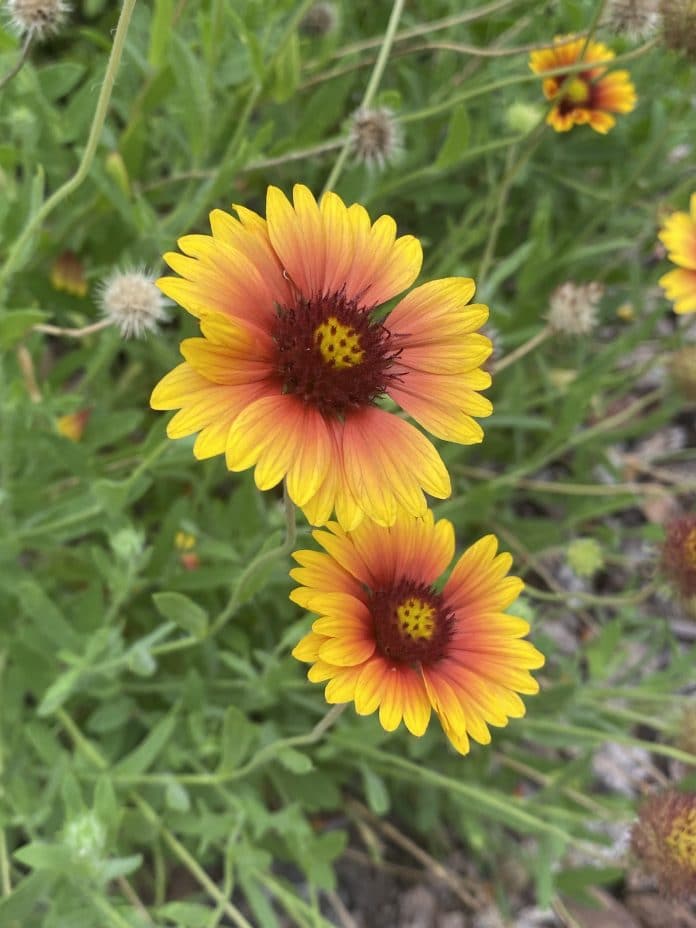On June 21, I joined the UF/IFAS Hernando County Extension’s Dr. William Lester, Lawn & Garden/Master Gardener Coordinator; Lily Browning, with Florida-Friendly Landscaping, and Master Gardener volunteer Alice Smith, where I learned about their native plant landscaping project that took place at the UF/IFAS Hernando County Extension office. The goal for this project was to replace the landscape in front of the UF/IFAS Hernando office with all Florida native plants. This project was completed throughout the pandemic and also has the continuous purpose of teaching locals that growing natives helps save on irrigation. Perfect timing for this native plants info session, as it was the first day of National Pollinator Week.
This project was first launched by a group of UF/IFAS Master Gardeners during the height of COVID as a way to get people outside in the fresh air and sunshine, where they could safely distance themselves from each other as well. Alice and other gardeners swapped out the landscape in front of the office so everything out there now is a Florida native plant and they look beautiful! Dr. Lester stated that a lot of people think that native Florida plants only look like weeds, but a lot of them flower and are very eye-catching. Let the extension office attest to that!
What determines a native plant, is if scientists can determine if the plant was here in 1513, when Ponce De Leon arrived. However, fossil records of the Florida native plant called the Coontie, have been dated to 25 million years old.
On top of being beautiful, another plus for planting natives is that they require very low maintenance, besides weeding. You don’t have to spray pesticides or fertilizer often, the less chemicals released into the environment the better. After the plant’s roots are established, the plant will be just fine without any other irrigation except during periods of drought. Even then, simply taking your water hose or a portable watering can over the plants will do the trick. Alice Smith explained that the Florida native, the Gaillardia or blanket flower does well in low water landscapes especially sandy soils, which we have here in Hernando County. It also adapts to all kinds of soils throughout Florida. It’s an annual, so once the season is over the plant recedes in the winter but in the spring, you’ll have new plants coming in to replace the ones that have died.
Another huge plus to planting natives, is giving food to our pollinators. Alice Smith commented on the flowers at the Hernando office, “After we planted them and they started to bloom, the pollinators showed up. Now we have native bees, honey bees, wasps and butterflies.” Host plants for butterflies are native wild flowers and vines. For example, Alice planted native common Buckeye which she spotted a ton of caterpillars on recently, even a chrysalis! It’s gone now so she assumes it became a lovely butterfly. Corceestan Passion Vine is another good host plant for butterflies and especially for our state butterfly, the Zebra Long Wings.
Along with planting natives for our pollinators, you’re planting for our bird population too, which has seen a rapid decline in the past years, especially our migratory birds. You’re providing insect nutrients for birds and their babies when they nest. During the current climate crisis, native plants are the best to plant. They have evolved over millennia and have endured the effects of climate change before, providing constant nutrients to your local wildlife. “If your plants don’t have holes in them, then they’re not adding to the ecosystem,” stated Alice. When planting natives for your home, keep biodiversity in mind as to attract a variety of pollinators, not only plant specific ones.
The UF/IFAS Master Gardeners have a plant nursery located behind the Hernando County Fairgrounds near Hernando County Animal Control. Turn east off US Hwy 41 onto Oliver Street. Here they offer a variety of locally grown plants as well as a ton of Florida native plants, a lot of these are hard to find in the big stores. They’re open Wednesday and Saturdays 8:30-12pm, ready to provide plant and gardening expertise. Alice Smith also was kind enough to provide me with a list of native plants for low water landscaping in West Central Florida.
Please stop by the Hernando County Extension office to learn more about each of the Florida natives that are planted out front or for assistance on how to get started planting natives. Each plant in front of the office has a QR code posted with it that will bring you to a website with more information about that specific plant.
You could always call the UF/IFAS Hernando office to rack their brains with all of your gardening questions.

